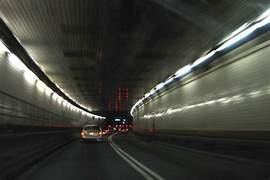The completion of the 1927 Holland Tunnel under the Hudson River marked a significant milestone in the history of transportation and engineering in the United States. This groundbreaking project, which connected the island of Manhattan in New York City to Jersey City in New Jersey, not only revolutionized the way people commuted between these two states but also set a precedent for the construction of underwater vehicular tunnels worldwide. The need for a direct tunnel between Manhattan and New Jersey had been apparent for years, as the region was experiencing rapid growth and increasing traffic congestion. Prior to the Holland Tunnel's construction, the only means of crossing the Hudson River were by ferry or using the congested streets of New York City, both of which were time-consuming and inefficient. The idea of a vehicular tunnel beneath the river had been explored as early as the late 19th century, but it was not until the 20th century that the technology and resources were available to turn this vision into a reality. Construction of the Holland Tunnel began in 1920 and was overseen by the Holland Tunnel Construction Company, a consortium led by Clifford M. Holland and comprised of several prominent engineers and architects. Tragically, Clifford Holland passed away in 1924 during the construction due to complications from appendicitis. His legacy was carried on by engineers such as Milton Freeman and Ole Singstad, who ensured the project's completion. The tunnel's design and construction presented formidable challenges. It extended for approximately 8,500 feet (2,600 meters) under the river, and engineers had to contend with the formidable pressures and conditions of the riverbed, not to mention the ever-present risk of flooding. The tunnel was constructed using a pioneering approach, involving a cast-iron shield with hydraulic jacks to bore through the riverbed and then lining the tunnel walls with cast-iron rings. This innovative technology allowed workers to excavate the tunnel safely and efficiently while minimizing the risk of a catastrophic breach. The Holland Tunnel was officially opened to the public on November 13, 1927. The opening ceremony was a grand event attended by dignitaries, including President Calvin Coolidge, who hailed it as an engineering marvel. The tunnel was an immediate success, providing a faster and more convenient means of crossing the Hudson River. It revolutionized the daily lives of commuters, making it easier for people to live in New Jersey and work in Manhattan, and vice versa. The completion of the Holland Tunnel set a precedent for the construction of vehicular tunnels across the world. Its success and innovative engineering techniques inspired the development of numerous other underwater tunnels, including the Lincoln Tunnel, which opened in 1937, connecting New York City to Weehawken, New Jersey. These tunnels played a crucial role in the growth and development of the entire metropolitan region. Over the years, the Holland Tunnel has undergone several renovations and expansions to accommodate the ever-increasing volume of traffic. Today, it remains a vital transportation link, serving millions of commuters and travelers annually. The tunnel has become a symbol of progress and innovation in civil engineering, demonstrating the capacity of human ingenuity to conquer formidable challenges.
1927 Holland Tunnel under the Hudson River Completed
